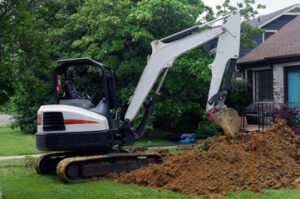Excavation is a complicated and physically demanding process. It requires a number of supplies and calculations, and it is a necessary part of almost every construction project. Here are some facts about this process. Let’s take a closer look. Extensive research is required to perform an excavation correctly.

Excavation is a complex and physically demanding process, which requires a range of different equipment. Excavation machinery ranges from small backhoes to large earth-moving machines. These machines are often used for developer-led excavations and for salvage archaeology. Mechanical excavators are the fastest way to excavate a site and prepare the surface for hand excavation, but they must be operated carefully to avoid damaging archaeological deposits.
Regardless of the type of excavation machinery used, the process involves removing a layer of soil directly beneath the topsoil layer and the rock layer that lies beneath. While there are similarities between the two types of material, the primary distinction between these is that earth is less dense than rock and can be broken down into smaller pieces. When this material is excavated, it can be hauled away or incorporated into a foundation or embankment. Unclassified excavation, on the other hand, is a general term for any combination of materials that are excavated. The process of excavation is often complicated and involves specialized equipment that varies with the material encountered.
Archaeologists commonly use stratigraphic excavation, which involves removing layers of soil layer by layer. This allows them to reconstruct the timeline of archaeological deposits. The excavated layers are often dated and processed by mechanical means. In addition, they can be spot-dated. They may also go through a process called flotation to extract valuable artifacts. Finally, the results of the excavation are recorded digitally with photographs and videos. This data is important in reconstructing the site and its contexts.
Several calculations are involved in the process of excavation. These calculations are used to determine the depth and size of the excavation. They are also used to determine the slope. The slope must be 75% outward from the beginning of the excavation. You can use a chart to calculate the slope and the width and depth of the excavation.
The stability of excavations depends on their ground conditions. In blocky-to-disintegrated rock, excavations are prone to failure. These excavations are affected by structural controls such as joints, bedding, shears, and discontinuities. One of the common failure modes is M22, characterized by localized brittle failure of intact rock blocks bounded by open joints and shears.
Mass conservation is also an important aspect of excavation. Having too much-cut material means that project managers will have to dump the excess or bring dirt from another location, increasing the material costs. That’s why it’s essential to plan projects so that the cut and fill mass are approximately the same.
When working with earth, the excavation process requires many different types of supplies. For example, it is necessary to use the correct level of soil around the excavation to ensure that the area is stable. Loose soil can cause the ground to settle and is a hazard. Also, adverse weather conditions can make soil conditions worse. Rain and melting snow can saturate the soil and reduce its strength. It is also important to consider the temperature of the site, which can fluctuate throughout the day. These changes can also make the ground more unstable, increasing the likelihood of a cave-in. To mitigate these problems, workers should prepare for the weather conditions and plan ahead for the construction project.
Excavation work also creates potential fire hazards. Proper barriers and protective equipment can minimize the risk of fire. Also, workers should be aware of any underground utilities and make sure that they are protected from them. Lastly, it is important to maintain adequate first aid equipment. In addition, construction work draws large numbers of pedestrians, making it a dangerous environment for children and the general public. Therefore, adequate barriers and warning lights should be present during excavation work to ensure the safety of everyone in the area.
There are many types of equipment used in excavation. The right equipment for the job will make the process go smoothly. The equipment must be in top condition and should not smoke. It must also be regularly tested to prevent accidents and delays. By having the proper equipment, you’ll ensure that your project won’t be delayed or cost more than it should.

